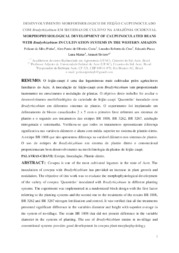Desenvolvimento morfofisiológico de feijão caupi inoculado com Bradyrhizobium em sistemas de cultivo na Amazônia Ocidental.
Desenvolvimento morfofisiológico de feijão caupi inoculado com Bradyrhizobium em sistemas de cultivo na Amazônia Ocidental.
Author(s): PINHO, P. da S.; COSTA, A. P. de O.; CRUZ, L. R. da; MATTAR, E. P. L.; SIVIERO, A.
Summary: O feijão-caupi é uma das leguminosas mais cultivadas pelos agricultores familiares do Acre. A inoculação de feijão-caupi com Bradyrhizobium tem proporcionado incremento no crescimento e nodulação de plantas. O objetivo deste trabalho foi avaliar o desenvolvimento morfofisiológico da variedade de feijão-caupi ´Quarentão´ inoculado com Bradyrhizobium em diferentes sistemas de plantio. O experimento foi implantado em delineamento de blocos casualizados 2 x 5 com o primeiro fator referente aos sistemas de plantio e o segundo aos tratamentos das estirpes BR 1808, BR 3262, BR 3267, adubação nitrogenada e testemunha. Verificou-se que todos os tratamentos apresentaram diferença significativa nas variáveis diâmetro e altura com média superior no sistema de plantio direto. A estirpe BR 1808 que não apresentou diferença na variável diâmetro nos sistemas de plantio. O uso de estirpes de Bradyrhizobium em sistema de plantio direto e convencional proporcionaram bom desenvolvimento na morfofisiologia da plantas de feijão caupi. Cowpea is one of the most cultivated legumes in the state of Acre. The inoculation of cowpea with Bradyrhizobium has provided an increase in plant growth and nodulation. The objective of this work was to evaluate the morphophysiological development of the variety of cowpea ´Quarentão´ inoculated with Bradyrhizobium in different planting systems. The experiment was implemented in a randomized block design with the first factor referring to the planting systems and the second one to the treatments of the strains BR 1808, BR 3262 and BR 3267 nitrogen fertilization and control. It was verified that all the treatments presented significant difference in the variables diameter and height with superior average in the system of no-tillage. The strain BR 1808 that did not present difference in the variable diameter in the systems of planting. The use of Bradyrhizobium strains in no-tillage and conventional systems provides good development in cowpea plant morphophysiology.
Publication year: 2019
Types of publication: Paper in annals and proceedings
Unit: Embrapa Acre
Keywords: Acre, Agronomic traits, Amazonia Occidental, Amazônia Ocidental, Bactéria, Bradyrhizobium, Campo Experimental, Características Agronômicas, Caupi, Cero labranza, Cowpeas, Cropping systems, Cruzeiro do Sul (AC), Feijão de Corda, Fijación del nitrógeno, Fixação de Nitrogênio, Inoculación de la raíz, Inoculação Artificial, Nitrogen fixation, No-tillage, Plantio Direto, Raiz, Root inoculation, Sistema de Cultivo, Universidade Federal do Acre, Vigna Unguiculata, Western Amazon
Observation
Some of Embrapa's publications are published as ePub files. To read them, use or download one of the following free software options to your computer or mobile device. Android: Google Play Books; IOS: iBooks; Windows and Linux: Calibre.
Access other publications
Access the Agricultural Research Database (BDPA) to consult Embrapa's full library collection and records.
Visit Embrapa Bookstore to purchase books and other publications sold by Embrapa.

